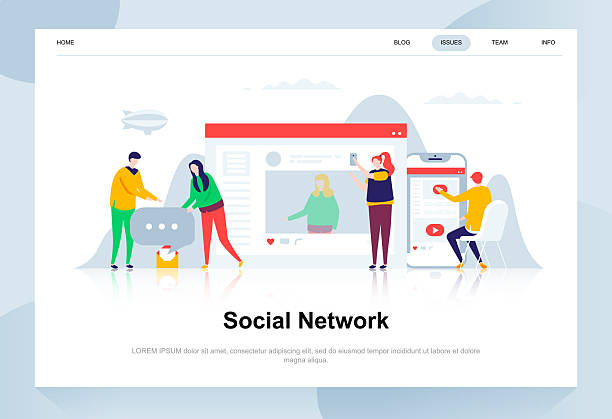Introduction to Secure Website Design and its Importance

In today’s digital world, where internet usage is constantly increasing, websites have become the backbone of businesses, organizations, and even personal lives.
However, with the increasing online presence, the #importance of #secure website design becomes more evident than ever.
An insecure website can lead to the loss of sensitive data, damage to brand reputation, and even significant financial losses.
Therefore, #creating a secure and stable website is no longer a luxury option, but an undeniable necessity.
Web security not only includes protecting user data but also ensures the stability and proper functioning of services.
Website security is a complex and multi-layered process that encompasses everything from initial design to continuous maintenance.
Without sufficient attention to these aspects, your website will be constantly exposed to cyberattacks.
Secure website design specialists must continuously update their knowledge of the latest threats and mitigation methods.
In this article, we will delve into various aspects of secure web development and provide practical solutions to strengthen the security foundations of websites.
This approach ensures that your site not only remains safe from potential attacks but also gains user trust and provides a secure and reliable user experience.
Paying attention to minor security details in secure website design can make a big difference in the stability and success of an online project.
This section serves as an introductory explanation, providing a basis for subsequent more specialized discussions.
Are you tired of losing business opportunities due to not having a professional corporate website?
Rasaweb helps you with professional corporate website design:
✅ Build a powerful and reliable image for your brand
✅ Convert website visitors into loyal customers
⚡ Get a free consultation now!
Common Website Security Threats

Understanding common threats and vulnerabilities is the first step on the path to secure website design.
Code injection attacks (SQL Injection, XSS) are among the most common methods hackers use to gain unauthorized access to databases or execute malicious code on the client side.
These attacks can lead to the theft of sensitive information, content modification, or even complete control of the website.
An SQL injection attack occurs when an attacker inserts malicious SQL code into website input fields, and these codes are executed by the database server.
In contrast, Cross-Site Scripting (XSS) attacks allow an attacker to inject malicious scripts into web pages and execute them in the victim’s browser, which can lead to the theft of cookies or session information.
DDoS (Distributed Denial of Service) attacks also cripple a website by sending a massive volume of traffic to its server, disrupting access for legitimate users.
Weaknesses in authentication and session management also open the door for intruders, allowing them to enter the system by accessing user credentials.
Software vulnerabilities in frameworks, plugins, and Content Management Systems (CMS) are also common entry points for attackers; therefore, regular updates and the use of stable and secure software versions are fundamental principles in secure web development.
Another serious threat is phishing attacks, in which attackers try to obtain sensitive user information such as usernames and passwords by impersonating a legitimate site.
Continuous awareness and analysis of these threats play a vital role in secure website design and help developers implement effective preventive solutions.
This analytical approach provides a strong foundation for the subsequent stages of secure website design.
Fundamentals of Secure Website Design from an Architectural Perspective

Secure website architecture is the cornerstone of any secure website design project.
From the very beginning of the development process, security principles must be integrated into all layers of the system.
This approach, known as “security by design”, means considering security issues at every stage, from initial design to deployment and maintenance.
Using a multi-layered architecture, with clear separation between presentation, business logic, and data access layers, can help limit the scope of attacks in case of a breach.
For example, placing the database on a separate network and restricting access to it via a firewall is a fundamental principle.
Implementing Web Application Firewalls (WAFs) can provide an additional layer of protection against common attacks like SQL Injection and XSS.
WAFs inspect incoming and outgoing traffic and block malicious traffic.
Also, applying the “Principle of Least Privilege” for users and services means that each entity only requires the minimum necessary access to perform its tasks.
This limits the scope of vulnerabilities if an account or service is compromised.
Proper management of server and software configurations, disabling unnecessary services, and deleting default and sensitive files are other important aspects of secure architecture.
To ensure secure website design, the architecture must be regularly reviewed and tested to identify and address potential weaknesses.
This specialized approach provides a strong framework for secure web development.
Table 1: Key Principles of Secure Website Architecture
| Security Principle | Description | Benefits |
|---|---|---|
| Security by Design | Integrating security considerations from the beginning of the software development lifecycle. | Reduced remediation costs, early identification of vulnerabilities. |
| Principle of Least Privilege | Granting the minimum necessary access to users and systems to perform their tasks. | Limiting the scope of damage in case of a breach. |
| Layer Separation | Separating presentation, logic, and data layers for improved security and maintainability. | Limiting attack propagation, improving system robustness. |
| Web Application Firewalls (WAF) | A tool for filtering and monitoring HTTP traffic between the website and the internet. | Protection against common OWASP Top 10 attacks. |
The Role of Secure Communication Protocols

One of the most fundamental pillars of secure website design is the use of secure communication protocols.
Standard HTTP sends information in plain text, which allows attackers to eavesdrop on and tamper with data.
This is where HTTPS comes into play.
HTTPS (Hypertext Transfer Protocol Secure) is a secure version of HTTP that uses SSL/TLS (Secure Sockets Layer/Transport Layer Security) for data encryption.
By implementing HTTPS, all communications between the user’s browser and the website server are encrypted.
This encryption ensures that sensitive data such as login information, credit card details, and other personal information are protected from eavesdropping or tampering during transmission.
To implement HTTPS, you need an SSL/TLS certificate issued by a trusted Certificate Authority (CA).
This certificate assures the user’s browser that it is connected to the correct server and that the website’s identity is verified.
In addition to preserving data privacy and integrity, using HTTPS also has SEO benefits, as search engines like Google prefer websites that use HTTPS in their search rankings.
Complete migration to HTTPS with 301 redirects is an important issue in secure web development to ensure all traffic is directed through a secure channel.
This action not only enhances user security but also contributes to the overall improvement of the website’s credibility and ranking, serving as a guiding step in the path to strengthening secure website design.
Are you bothered by losing customers due to your online store’s outdated appearance or slow speed? Rasaweb’s expert team solves these problems permanently with professional e-commerce website design!
✅ Increase customer trust and your brand’s credibility
✅ Stunning speed and excellent user experience
⚡ Click now to get a free consultation with Rasaweb!
The Importance of Updates and Vulnerability Management

One of the often-overlooked but vital aspects of secure website design is the continuous management of updates and vulnerabilities.
Software used in websites, including server operating systems, web servers (such as Apache or Nginx), databases (such as MySQL or PostgreSQL), programming languages (such as PHP, Python, Node.js), frameworks, plugins, and Content Management Systems (CMS) like WordPress or Joomla, are constantly subject to the discovery of new vulnerabilities.
Hackers continuously look for these weaknesses to exploit them for system penetration.
Regular updating of all software components of the website is the first and most important line of defense against these threats.
Developers and website administrators should actively follow security news and update announcements related to their used software and apply security patches as soon as they are released.
This process not only includes software updates but also extends to operating system updates and even hardware updates if necessary.
Using vulnerability scanning tools can help identify system weaknesses before they are discovered by attackers.
These tools can automatically scan the system for known vulnerabilities and provide reports on how to fix them.
Ultimately, having a comprehensive vulnerability management program, which includes identification, assessment, prioritization, and remediation of vulnerabilities, is essential for maintaining a secure website environment.
This informative and instructive approach significantly contributes to maintaining website stability and security.
Database Security in Web Design

The database is the beating heart of any website, storing vital user information, content, and settings.
Therefore, securing the database is a top priority in secure website design.
One of the most common attacks against databases is SQL Injection, as mentioned earlier.
To counter this, it is crucial to use Parameterized Queries (Prepared Statements) or ORMs (Object-Relational Mappers) instead of directly structuring queries from user inputs.
These methods ensure that user input is treated as data, not executable code.
Furthermore, encrypting sensitive data in the database, especially users’ personal and financial information, is vital.
Even if the database is breached, encrypted data will be useless without the decryption key.
Using strong encryption algorithms and securely managing decryption keys is of paramount importance.
Applying the Principle of Least Privilege to database user accounts is also very important.
Each user or application should only have the minimum necessary access to perform its tasks; for example, a website user does not need admin access to the database.
Restricting physical and network access to the database server, using strong firewalls, and performing regular and secure data backups are also essential measures in secure website design.
Additionally, continuous monitoring of database logs to identify suspicious and unusual activities helps in quickly detecting and responding to security incidents.
This specialized approach guarantees the integrity and confidentiality of data throughout secure web development.
User Authentication and Access Management

One of the common weaknesses in websites is inadequate authentication and access management systems.
Strong authentication and precise access management are considered the backbone of a secure website design.
Weak passwords, the absence of Multi-Factor Authentication (MFA), and improper user session management provide significant opportunities for attackers.
It is recommended that websites implement strong password policies, which include minimum length, and the use of a combination of uppercase and lowercase letters, numbers, and special characters.
Also, user passwords should be stored as hashes using strong hashing functions (such as Argon2 or bcrypt) instead of direct storage, and the use of weak algorithms (such as MD5 or SHA-1) should be avoided.
Implementing Multi-Factor Authentication (MFA) adds a critical layer of security.
Even if a user’s password is compromised, the attacker cannot access the system without the second factor (such as a code sent to a mobile phone or a fingerprint).
User session management must also be performed carefully.
Sessions should have an expiration time and automatically expire after user logout or prolonged inactivity.
Using Secure Cookies and the HttpOnly flag for session cookies prevents Session Hijacking.
Furthermore, Role-Based Access Control (RBAC) ensures that each user only has access to the resources and functionalities they are authorized to access.
This is especially critical for admin panels and administrative access.
These measures not only help to improve secure website design but also significantly increase user trust.
Table 2: Best Practices for Authentication and Access Management
| Security Element | Description | Impact on Security |
|---|---|---|
| Strong Password Policy | Enforcing the use of long, complex, and unique passwords. | Reduces the risk of Brute-Force and Dictionary attacks. |
| Password Hashing | Storing passwords as hashes with strong algorithms (e.g., bcrypt). | Protects passwords in case of a database breach. |
| Multi-Factor Authentication (MFA) | Requiring more than one factor to verify user identity (e.g., password and SMS code). | Significantly increases security against credential theft. |
| Secure Session Management | Using secure cookies, session expiration, and session ID regeneration. | Prevents Session Hijacking attacks. |
| Role-Based Access Control (RBAC) | Granting access based on defined user roles. | Limits unnecessary access and reduces the attack surface. |
Penetration Testing and Security Assessment

After implementing secure website design and adhering to secure web development principles, the next step is to ensure the effectiveness of these measures.
This is where Penetration Testing and security assessments come into play.
Penetration testing is the simulation of a real cyberattack on your website, performed by security specialists (ethical hackers) to identify vulnerabilities and weaknesses that real attackers might exploit.
This process can include automated scanning for known vulnerabilities, as well as more complex manual tests to discover hidden logic flaws and design weaknesses.
The goal of penetration testing is not only to identify vulnerabilities but also to assess their impact and provide practical solutions for remediation.
Penetration test results should be provided in detailed reports that include a description of the vulnerability, its risk level, and suggested remediation steps.
Penetration testing should be performed regularly and periodically, especially after major changes to the website’s code or infrastructure.
In addition to penetration testing, Security Audits and Code Review can also help strengthen website security.
Security audits involve reviewing security policies, procedures, and controls to ensure their compliance with best practices and industry standards.
This educational and guiding process continuously ensures that implemented security measures are efficient and effective, leading to the development of a secure and stable website.
Do you have an online store, but your sales are not as expected? Rasaweb, with professional e-commerce website design, solves your problem permanently!
✅ Significant increase in conversion rate and sales
✅ Unparalleled user experience for your customers
⚡ Click now to get a free consultation with Rasaweb!
Security Incident Response and Recovery

Even with adherence to all principles of secure website design and implementation of best security practices, no website is completely immune to cyberattacks.
Security incidents can occur, and readiness to respond to them and recover quickly is of critical importance.
Having a well-documented and practiced Incident Response Plan helps organizations minimize damages in the event of a breach and quickly return to normal operation.
This plan should include the stages of identification, containment, eradication, recovery, and lessons learned.
Identification means rapidly detecting the incident through log monitoring, Intrusion Detection/Prevention Systems (IDS/IPS), and user reports.
Containment involves actions to prevent the spread of the attack, such as isolating infected systems or disconnecting them from the network.
Eradication means completely removing the intruder’s presence from the system, for example, by removing malware or patching vulnerabilities.
Recovery involves restoring systems and data to their operational state before the incident.
This stage emphasizes the importance of regular and secure data backups.
Complete and reliable backups are the last line of defense against data loss.
Ensuring that backups are periodically tested for integrity is crucial.
Finally, lessons learned from each security incident are essential for improving future security policies and controls to prevent similar incidents from recurring.
This explanatory and guiding approach ensures that, even when facing challenges, your secure website design maintains its stability.
The Future of Secure Website Design and Emerging Trends
![]()
The world of cybersecurity is constantly evolving, and with the emergence of new technologies, threats also become more complex.
Secure website design must also keep pace with these changes.
One of the most important emerging trends is the use of Artificial Intelligence (AI) and Machine Learning (ML) in cyber defense.
These technologies can identify suspicious traffic patterns, predict unknown attacks, and automate incident response, which significantly increases the efficiency of security measures.
However, at the same time, AI can also be a tool in the hands of attackers, making attacks more sophisticated.
Zero Trust architecture is another key concept that is changing organizations’ approach to security.
Unlike traditional security models based on “trust” within the network, Zero Trust assumes that no user, device, or application, whether inside or outside the network, is trustworthy by default.
This model requires continuous verification of identities and access and thoroughly inspects every connection and request to ensure secure website design.
The emergence of Web 3.0 and blockchain technology also creates new challenges and opportunities for web security.
While blockchain promises high security and transparency, its improper implementation can lead to new vulnerabilities.
The need for API security has also become more vital with the expansion of web and mobile applications that heavily rely on APIs.
Secure website design developers must be prepared to face these emerging trends and implement innovative solutions to protect websites against future threats.
This is an engaging yet thought-provoking approach that invites us to think more deeply about the future of web security.
Frequently Asked Questions
| Question | Answer |
|---|---|
| What is secure website design? | Secure website design is the process in which websites are built with security principles in mind to be resilient against cyberattacks and to protect user and business information. |
| Why is secure website design of high importance? | To prevent unauthorized data access, leakage of sensitive information, malware attacks, loss of user trust, damage to business reputation, and legal consequences arising from data breaches. |
| What are the most common website vulnerabilities? | SQL Injection, Cross-Site Scripting (XSS), Cross-Site Request Forgery (CSRF), broken authentication and session management, and sensitive data exposure. |
| How can SQL Injection attacks be prevented? | By using Prepared Statements with Parameterized Queries, Input Validation, and restricting database access. |
| What are the methods to counter XSS (Cross-Site Scripting) attacks? | User Input Validation, Output Encoding before displaying in HTML, and using Content Security Policy (CSP). |
| What is the role of HTTPS in website security? | HTTPS encrypts communication between the user’s browser and the website server using an SSL/TLS certificate, preventing eavesdropping, tampering, or forgery of data. |
| What are the best practices for managing user passwords? | Enforcing strong passwords (a combination of letters, numbers, and symbols), hashing passwords instead of direct storage (with strong algorithms like bcrypt), and enabling two-factor authentication (2FA). |
| What is the importance of User Input Validation? | Input validation prevents malicious or unexpected data from entering the system, which can lead to vulnerabilities such as SQL Injection or XSS. |
| What impact do regular security reviews and audits have on site security? | These reviews help in early identification of vulnerabilities and security weaknesses, allowing them to be addressed before they can be exploited. |
| What is the use of Web Application Firewall (WAF) in secure website design? | A WAF acts as a protective layer between the user and the website, analyzing incoming traffic and identifying and blocking common web attacks like SQL Injection and XSS. |
And other services of Rasaweb Advertising Agency in the field of advertising
Smart Advertising Campaign: A professional solution for digital branding with a focus on intelligent data analysis.
Smart SEO: Professional optimization for online growth using key page optimization.
Smart Google Ads: A combination of creativity and technology to improve SEO ranking through custom programming.
Smart Digital Branding: Designed for businesses seeking digital branding through intelligent data analysis.
Smart Sales Automation: Revolutionize campaign management with the help of Google Ads management.
And over a hundred other services in internet advertising, advertising consultation, and organizational solutions
Internet Advertising | Advertising Strategy | Advertorial
Resources
Important tips to increase your website security
Comprehensive Website Security Guide
Website Security; From Importance to Solutions
Secure Website Design: How to build a secure website?
? Are you looking to boost your business in the digital space? Rasaweb Afarin, with years of experience in digital marketing and corporate website design, is your comprehensive solution for online growth and success.
📍 Tehran, Mirdamad Street, next to Central Bank, Southern Kazeroun Alley, Ramin Alley, No. 6


